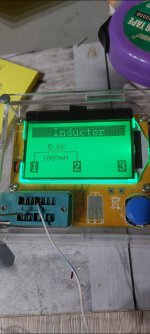It seems that most DVMs that I have used don't have much resistance accuracy below the 10 ohm mark. Is there anything that is accurate at that level? From 1 or 2 ohms to 10 ohms.
I would be ok with a straight ohmmeter with no other functions
I would be ok with a straight ohmmeter with no other functions
Not accurately, I have several of them.Even a cheap LCR meter can do it.
Look for DVMs with a "Low Ohms" function, or a "milli-ohm" meter.
You may need Kelvin connection (4 leads) for accuracy.
What are you measuring?
Example:
https://www.digikey.com/en/products/detail/aidetek/VC480C/21296778
You may need Kelvin connection (4 leads) for accuracy.
What are you measuring?
Example:
https://www.digikey.com/en/products/detail/aidetek/VC480C/21296778
I tought they are decent enough.
Well, you can DIY one , a constant current source and measure voltage drop on the resistor.
A 4-wire measurement setup can be precise.
Well, you can DIY one , a constant current source and measure voltage drop on the resistor.
A 4-wire measurement setup can be precise.
2 cheap multimeter and a voltage source with a resistor in series can do the job.
One multimeter measures the current and the other measures the voltage in the Kelvin 4-wire connection.
You can measure even ultra low resistance (few miliohms) such as engine starters, alternators etc.
It's a matter of adjusting the proper current to produce easy readable voltage/current.
One multimeter measures the current and the other measures the voltage in the Kelvin 4-wire connection.
You can measure even ultra low resistance (few miliohms) such as engine starters, alternators etc.
It's a matter of adjusting the proper current to produce easy readable voltage/current.
I use an old bench meter with Kelvin clips. Just google for milliohmmeter if you want to buy something.
https://www.amazon.com/s?k=milliohm+meter
https://www.amazon.com/s?k=milliohm+meter
I have an Amprobe LCR55A component tester that has a 20 ohm range with a trim pot to short the leads and zero the measurement, which has a 10 mohm resolution in this range. I use some short leads with crocodile clips I made and it works for me, don't know if it would be accurate enough for you.
From Aliexpress, very cheap but 4-wire, max 20R model :
https://vi.aliexpress.com/item/1005...t_main.17.94a518029RN4Gj&gatewayAdapt=glo2vnm
https://vi.aliexpress.com/item/1005...t_main.17.94a518029RN4Gj&gatewayAdapt=glo2vnm
The HP 4328 milliOhmeter is about as good as it gets. For very low Ohms there are a lot of errors like thermal junctions that cause problems even with Kelvin connections. The HP uses AC and synchronous detection to measure the resistive component down to 1 milliOhm full scale. There is a later digital version for $$$$. This one is $179 https://www.ebay.com/itm/2866287997...P7HRRqYAXIRWH4baaN44bu7w==|tkp:Bk9SR8KNuM7sZQ You can get probes on eBay.
There are also meters for checking battery impedance which can work and maybe an ESR checker could work but my experience with the cheap Asian knock offs have not been good.
This may be a good option https://www.ebay.com/itm/4051422960...HeY4O9x/bGR5XPbSIrnq4tXoo=|tkp:Bk9SR-ab787sZQ The price is right and it seems to have accuracy. The controls are all in Chinese but I'm sure Google can help. . .
There are also meters for checking battery impedance which can work and maybe an ESR checker could work but my experience with the cheap Asian knock offs have not been good.
This may be a good option https://www.ebay.com/itm/4051422960...HeY4O9x/bGR5XPbSIrnq4tXoo=|tkp:Bk9SR-ab787sZQ The price is right and it seems to have accuracy. The controls are all in Chinese but I'm sure Google can help. . .
When measuring low resistance like that, the unwanted series resistance added by the probe leads and their connectors, as well as contact resistance between the probes and what they touch, will add quite a bit of error to the readings. It's best to find a meter that has kelvin or 4-wire ohms measurement capability when reading low-ohms resistors like the 10 ohm one. One pair of wires sources a constant current though the Device Under Test (DUT), and the current stays constant regardless of probe & contact resistance, so long as that resistance is not so high that the current source can no longer keep the current constant (goes into compliance). The other two probes go to the meter's voltmeter, a very high resistance input, and as a result, there's no voltage drop in the probes and their contact points due to the microscopic currents involved. So one pair of wires sources the current and the other pair reads the voltage, and the result is an accurate measurement of the low resistance. For high resistances this is not needed because the errors, usually under an ohm, won't make much of a difference when reading, say, a 100K resistor.It seems that most DVMs that I have used don't have much resistance accuracy below the 10 ohm mark. Is there anything that is accurate at that level? From 1 or 2 ohms to 10 ohms.
I would be ok with a straight ohmmeter with no other functions
Ohmmeter accurate with 0.01-10 Ohms range is called milliohmmeter.It seems that most DVMs that I have used don't have much resistance accuracy below the 10 ohm mark. Is there anything that is accurate at that level? From 1 or 2 ohms to 10 ohms.
I would be ok with a straight ohmmeter with no other functions
Good example is YR-1035.
- Home
- Design & Build
- Equipment & Tools
- Ohmmeter that is accurate below 10 ohms?
